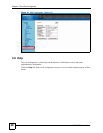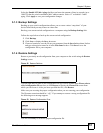
Chapter 4 The Web Configurator
ES-1552 User’s Guide
46
4.3.3 Change Your Password
After you log in for the first time, it is recommended you change the default administrator
password. Click System, Password to display the next screen.
QoS Use these screens to configure queuing with associated queue weights for the
switch.
Rate Use these screens to specify bandwidth limits and storm control limits for the
switch.
Port Rate Use this screen to cap the maximum bandwidth allowed from specified source(s) to
specified destination(s).
Storm
Control
Use this screen to cap the rate of broadcast, multicast and unknown unicast
packets the switch will allow on individual ports.
L2 Address Use these screens to view and manage the MAC address table.
Management Use this screen to add, delete or look up MAC addresses in the MAC address
table.
Display Use this screen to view the entries in the MAC address table.
Cable Diagnostic Use this screen to perform cable testing on individual ports.
Auto DoS Use these screens to activate security features against Denial of Service (DoS)
attacks.
Auto VoIP Use these screens to configure settings that automatically give higher priority to
Voice over Internet Protocol (VoIP) traffic.
Logging Use these screens to configure log settings and view system logs.
Settings Use this screen to configure which events the switch should log.
RAM Logs Use this screen to configure logs which are saved to volatile memory. These logs
are cleared when the switch is rebooted.
Flash Logs Use this screen to configure logs which are saved to non-volatile memory. You can
view these logs even after a switch is rebooted.
SNMP Use these screens to configure SNMP management settings.
Engine ID Use this screen to configure SNMP engine ID.
Group Use this screen to configure groups with different access rights for SNMP
management.
User Use this screen to create users and assign them to pre-defined SNMP groups.
Community Use this screen to define security parameters for SNMP v1 and SNMP v2c.
Trap Station Use this screen to configure settings that define when notifications are sent to an
external management station.
RMON-Lite Use this screen to configure Remote Network Monitoring Management Information
Base (RMON MIB) settings.
Dynamic ARP Use these screens to enable and configure ARP table settings.
Settings Use this screen to configure ARP table settings.
ARP Entries Use this screen to enter and view MAC address to IP address mappings.
Logout Click this to logout of the web configurator.
Table 4 Navigation Panel Links (continued)
LINK DESCRIPTION


















